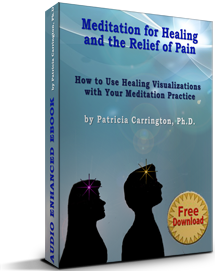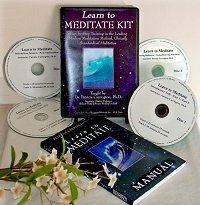Tips for Success in Meditating
Special Experiences during Meditation
, Ph.D.
Author of “The Book of Meditation”
As long as we have been meditating, a number of colleagues and I have intermittently kept meditation journals. The participants in my stress management seminars at Princeton and my students at the medical school have documented their meditations in the same way. The journal entries show that each meditation session tends to be a new and different experience, just as each dream is unique. Each meditator also appears to have their own characteristic style of meditating. This style may change and develop over time, as the following entries in my own meditation journal indicate:
When I first learned meditation, I would hear in my mind the two syllable mantra as a distinct word, usually personified. At first it seemed to come from a graceful feminine presence, a mermaid who swam before me during my meditation, calling to me in some strange yet intensely meaningful language – the language was the sound of my mantra. Sometimes the image was a bird soaring in the sky, leading me forward with its beautiful cry.
After several weeks of meditating, I no longer saw these ‘guiding images’ except when under particular stress, and the mantra became more indistinct, less word-like. After nine months of meditation I wrote:
Often my mantra is now present during a large portion of my meditative session as a faint but steady background beat continuing beneath my foreground thoughts and preoccupations. It goes its own way yet it harmonizes like the contrapuntal rhythms in Bach’s music. When it finally ‘takes over’ at some point during the meditation, the mantra becomes no longer a word but now just a pulsating rhythm, like slow rolling waves on the shore. The first syllable is the receding of the water; the second syllable is the long roll of the sea washing over the beach.
In the various forms of mantra meditation, the mantra itself may be experienced with seemingly infinite variety, At different times it may be loud, soft, fast, slow, melodic, harsh, resonant, muffled, clear, barely discernible, or may be experienced in some other fashion. One meditator described a form of thought during meditation which he said was deeply absorbing – during it the mantra was absent for long periods of time. When he found himself engaging actively with such thought, however, rather than flowing with it, the mantra reappeared spontaneously and continued along with his thinking, seeming to lead him back into his quiet state.
At certain times, meditators may experience a string of memories drifting through their minds during meditation. Sometimes
|
MEDITATION AUDIO LESSON Dr. Carrington's Personal Meditation Experiences
Dr. Patricia Carrington shares her initial experiences with meditation, the immediate benefits she personally gained when she first took up the practice of meditating, as well as how meditation affected her husband differently, yet also in a very positive way.
|
these are scenes of tranquil, nostalgic places from childhood, carrying with them a strong sense of pleasure. At other times disturbing images may arise. These usually tend to lose their painfulness as the meditation continues, changing under the soothing rhythm of the mantra or the peacefulness of one’s own breath quietly attended to, or just dissolving in the stillness.
Memories that emerge during meditation are often sensed as unusually vivid; it may seem to the meditator as though she is reliving an experience rather than remembering it. Meditators can almost smell the scents, taste the food, feel the touch on their skin, see the remote details of the scene involved – details they may not have previously recalled since the original event. These kinds of reliving do not seem to be stories with plots and do not have the structure of dreams. They are vivid impressions.
Aside from the imagery which may occur during meditation, the entire meditative session may be experienced in a manner which can best be described by comparing it with familiar images. My husband variously referred to his more positive meditative states as being like sitting high up on a mountainside listening to the wind; being by a fireside sipping fragrant tea; or watching a baby nursing peacefully. Others report that meditation has evoked in them a feeling of pleasant days in a quiet meadow, a boat rocking lazily at anchor, or a shower of cherry blossoms drifting toward the earth. The similes are endless and highly individual, but they also have certain things in common. Most of them depict tranquil moods. Often water, mist and rhythmic motions feature prominently in them.
The mantra, or any other object of focus used for meditation, may play a significant orienting and synthesizing function during meditation. As one meditator put it: ‘I searched for the mantra, and having found it felt ‘‘pulled together’’ (as being oriented by the North Star). I was coalesced.’ The experience of yielding to internal rhythms, of not ‘trying’, is also commonly reported: ‘I am in a state of alertness, yet without grasping or making any effort to cope. I do not try to succeed nor can I fail. Distant feelings, images, uninvited float into my ken, but there is no effort to define what I hear, see, sense . . .’
Occasionally during meditation, a meditator will have a spontaneous insight which may bring about a change in his life. I find these insights to be essentially similar to the deeper insights which may occur during psychotherapy, but with one difference – the preliminary conscious work leading up to the therapeutic insight is not present during meditation. The meditative process can even foster insights in people who have no previous experience in searching for meanings or causes for things that happen in their lives.
One other aspect of the meditative experience should be mentioned here. A meditation session will often follow a certain progression. Starting with an active type of thought, it may move toward more quiet types of thinking, and sometimes this process leads to a state where no thinking at all seems to occur. In mantra meditation, the mantra may become increasingly soft and indistinct as the meditation session continues, until, no longer needed, it gives way to profound quiet. In breathing meditation, awareness of the breath may recede until it becomes almost imperceptible and silence is the all-encompassing experience.
According to meditative tradition, at this point the mind is not focused on either thought or image, but is fully aware, conscious. The mind is said to be alert without having any object of alertness. This experience of utterly still awareness is one of the goals of the more advanced spiritual disciplines, although it is not necessarily a goal of the practical forms of meditation. This state, known as ‘transcending’ in TM, is not by any means experienced by all meditators who practice the simple centering techniques, perhaps not by the majority of them. Many people, if they have experienced it at all, have not identified it as being any special
|
MEDITATION AUDIO LESSON How to Fit Meditation into a Busy Lifestyle
How do you find time to meditate when you have a busy schedule? Dr. Carrington shares important considerations and information on mini-mediations to help you fit meditation into your busy lifestyle |
state of consciousness.
While attaining such an ‘objectless’ state is not necessary in order for personality change to take place, for those who do experience it, it seems to be deeply meaningful. One investigator has described this fleeting state as follows:
When, in full wakefulness, all inner activity comes to a stop, all thinking, all fantasy, all feeling, all images – everything – even the urge to think or to feel or to act; when all of this stops, stops on its own, without suppression or repression, one thing remains: a vast, inner stillness – a clear peace, and the firm realization that this, at the very least, is how it feels to be, simply, alive.1
Aware of what meditation as experience can be, we will now turn to the question of its management in everyday life. Understanding certain practical aspects of meditation can make the difference between a successful practice of this technique and a frustrating one. Browse the related meditation articles and audio lessons for ways of handling meditation.
1. J. C. Smith, ‘Transcendental Meditation and Anxiety’ (dissertation proposal, Michigan State University, 1973), p. 29.Ibid, p. 158.
Dr. Patricia Carrington's award winning meditation technique CSM (Clinically Standardized Meditation) is a clinically sensitive meditation method developed by the Medical Department of New York Telephone Company and used by numerous medical institutions, organizations, and individuals worldwide. For information click here.




